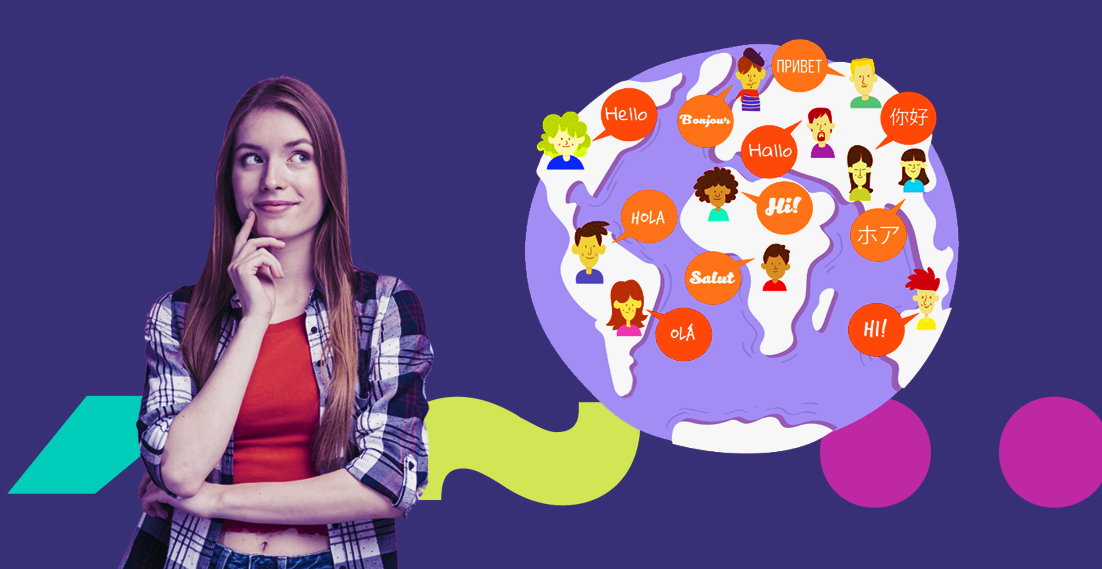The most frequently used language in the world and other language-related trivia

Have you ever wondered about the most commonly used language in the world? At first glance English may seem to be the answer. However, it turns out that there are two other languages spoken by even more people around the world. If you are interested in this topic, we encourage you to continue reading.
What are the world’s most frequently used languages?
There are currently over 7.7 billion people in the world. It is worth knowing that only 5 of the most-used languages in the world are native to around 2.6 billion people, which is just over 1/3 of the entire global population. What languages are they?
5. Arabic
The least popular language among the top languages is Arabic. Currently, it is used by about 295 million people. It was established around the 7th century AD and inextricably linked to the emergence of the religion of Islam, as well as the beginnings of the Muslim empire. Interestingly, it is the official language of as many as 24 countries, including Qatar, Iraq, Egypt, Kuwait, Jordan, Chad and Mauritania.
4. Hindi
The fourth language in terms of universality is Hindi, which is currently spoken by approximately 381 million people. The vast majority of its users live in India. It is also still spoken in Nepal, Fiji, Mauritius and Suriname. An interesting fact is that Hindi is derived directly from an ancient language called Sanskrit. It is created by a lot of modern dialects, hence the huge diversity of Hindi, which causes a lot of problems for modern linguists. Because of this diversity, knowing one of the dialects does not mean that you will be able to communicate with anyone who speaks Hindi.
3. English
There is a problem with assessing the English language popularity. If we talk about how many people use it as their mother tongue, then it really should take 3rd place, because this is the case with 372 million people around the world. However, if we consider the number of people for whom it is a second language the number of users increases to 612 million, which theoretically gives it the 2nd place in the world in terms of popularity. What’s more, it is estimated that nearly 984 million people around the world are able to communicate in English, which should definitely rank it at 2nd place. Nevertheless, let’s assume the criterion of native language and in this respect English definitely loses to…
2. Spanish
… Spanish. It is used as the native language of nearly 437 million people worldwide, in approximately 20 countries. Among the countries in which Spanish is the official language, there are also those that are gaining more and more economic importance. In addition to Spain, Spanish is spoken in Mexico, the Dominican Republic, as well as in Paraguay, Venezuela, Cuba and many other places in the world. Interestingly, it is also one of the official languages of several states in the USA (e.g. New Mexico).
What is the most widely used language in the world? It’s Chinese!
One thing is beyond doubt – Chinese is by far the most widely used language in the world, which is the native language of nearly 1.3 billion people. It is also estimated that the total number of its users is almost 1.5 billion. However, you should know that Chinese actually consists of Mandarin, Wu and Yue. However, they are classified within one group, mainly due to the fact that they are based on one writing system. There are also theories that individual languages (Mandarin, Wu or Yue) are only dialects of the Chinese language, although disputes about this are ongoing.
How many languages are there in the world?
Since we are talking about languages, it is worth being aware of one key aspect. Although the top 5 languages are used by around 33% of the total population, together they account for just over 0.07% of all world languages. There are currently between 6,000 and 7,000, and the difficulty in determining a specific number is the unclear difference between language and dialect. Regardless, it is estimated that more than half of current languages will die out by 2100, which can be unpleasant news for enthusiasts of linguistics.
What languages face extinction?
Which languages are at risk of disappearing completely? A lot of information on this subject is brought by the project entitled “The Endangered Languages Project”, which lists 3,418 languages in danger of extinction. These include, above all, Resígaro, Ocaina, Patwin, and Ossetian.
Linguists also point to entire language families that may soon be gone. These include in particular:
• Abkhazian-Adygian languages spoken by the inhabitants of the eastern Black Sea coast;
• Chukchi-Kamchatkan languages spoken by the inhabitants of Siberia;
• Yeniseian languages, which are also spoken by the people of Siberia;
• Australian languages spoken by native Australian people.
Which language families are the most common?
On the other hand, Indo-European languages are in a completely different position. They are used by almost 45% of all inhabitants of the Earth on a daily basis. It includes English, Polish, Spanish and Hindi. So you can basically say that 3 of the 5 most-used languages in the world belong to the Indo-European family.
The second language family in terms of widespread use are Chinese-Tibetan languages, spoken by around 22% of the world’s population. They include, among others Chinese, as well as much less known Pwo, Brek, Kayah or Burmese.
It is also worth knowing that Arabic belongs to the group of Semitic languages which are a part of the Afro-Asian language family. It is spoken by around 5% of the inhabitants of the globe and besides Arabic, this group includes Egyptian, Libyan, Tamasheq/Tuareg or Somali.
Which country uses the most languages?
Theoretically, knowing 3 of the 5 most-used languages in the world, you’ll be able to get along with just about anyone. The situation is slightly different when it comes to language richness in some countries. In India alone there are about 400 live languages, of which 21 are official. However, knowing English will do the trick in official matters, because it is also one of the official languages in India.
It also looks interesting in South Africa. Although there are significantly fewer live languages there, there are far more commonly used official languages. In total, there are 11 languages that are in use not only in individual regions (as the case is in India), but also all throughout South Africa. It is hard to resist the impression that the work of an official in this country is not the easiest one.
Notwithstanding all the above considerations, Papua New Guinea is the leader among the countries with the most languages. This cannot be seen at first glance, at least from a formal point of view, because there are only 3 official languages there. However, there are over 750 languages in everyday use! This represents around 12% of all world languages.
Why learn languages?
A justified question arises: Why study languages when there are so many? The answer is inseparably connected with the list of the most commonly used ones. In practice, knowing only English will allow you to get along almost anywhere in the world. In addition, knowledge of languages makes it easier to find a much better pay, especially if you know, for example, Norwegian, Arabic or the speech of another wealthy country with which companies want to do business. If necessary, we encourage you to use our language services which you can order in a very simple way – just use our convenient form!
Translation services? We will provide it!
Marketing translation as the key to success of the fashion industry. Cooperation with a popular fashion brand
We cooperated with many customers on a daily basis. They include local companies, international enterprises and well-known brands. What are the similarities between all of them? Everyone expects high-quality translations that will help in business development. Additionally, professional translations affect their image, contribute to the opinions of recipients and are the decisive factor when it […]
Hemingway Editor and other tools for text proofing and translation
Typically, content writers first note down the message they wish to put across to their audience. Then, they re-read and edit the text. This way, they can achieve better readability, understanding and structure, and at the same time they can correct any errors in the content. It is a complex process, but fortunately there are […]
Translation of advertising slogans – how not to fall into the language trap?
Advertising translation involves the process of transferring advertising messages from one market to another. The advertising discourse is created in a language that is not only a communication tool, but also an expression of culture. This makes ad translation a highly accuracy-demanding activity. Translating slogans requires both a cultural and linguistic connection. Adapting a brand […]
TOP 8 languages for e-commerce purposes. Sourcing customers around the world
Do you manage an e-shop and want to source customers abroad to increase profit? Translations will be the basis for reaching foreign recipients with your offer. You need to start speaking their language and adjust product or service descriptions to the country where you intend to sell them. You’re probably wondering which languages to start […]



